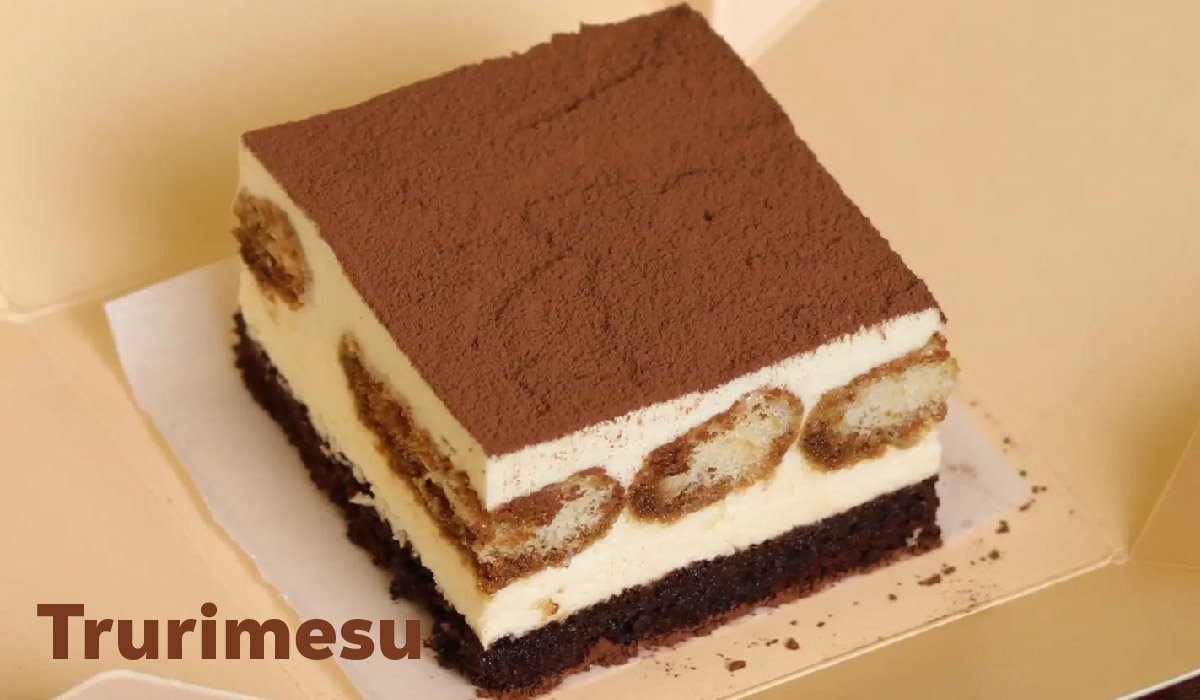Blog
Trurimesu Recipe That Will Blow Your Mind: A Bold Twist on Tiramisu

Imagine digging your spoon into a dessert that doesn’t whisper, but roars—one that doesn’t settle for being elegant, but insists on being unforgettable. That’s what trurimesu promises. At first glance, it might look like tiramisu’s cooler, more rebellious cousin. But one bite in, and you realize this is something else entirely. Trurimesu is not just a reinterpretation—it’s a bold reinvention of a classic, bursting with contrasting flavors, explosive textures, and visually striking elements that demand attention.
In today’s world, where food is no longer just about taste but also about experience, story, and shareability, trurimesu emerges as the kind of dessert that gets talked about. It taps into our collective hunger for novelty, cultural fusion, and food that makes us feel something—not just full, but thrilled. This isn’t your nonna’s tiramisu—it’s a post-modern dessert, tailor-made for the Instagram generation but deeply rooted in culinary craft.
What is Trurimesu? Definition & Key Features of a Game-Changing Dessert
Trurimesu, pronounced troo-ree-may-soo, is a coined term derived from the word “tiramisu,” but reimagined to signal innovation, boldness, and creativity. While tiramisu means “pick me up” in Italian, trurimesu means “wake up your senses.” At its core, it is still a layered dessert—but every layer has been given a makeover. Instead of sticking to the standard ladyfingers and cocoa dusting, trurimesu swaps in elements like sponge cake soaked in espresso-bourbon syrup, whipped mascarpone with yuzu and miso, and toppings like matcha, chocolate shavings, sea salt, or even torched marshmallow.
It’s a philosophy of dessert maximalism where each component contributes not only to flavor but to texture, presentation, and mood. From sponge to cream to topping, everything about trurimesu is elevated, unexpected, and dramatic. It’s the kind of dessert that belongs on a pedestal—and definitely in your recipe book.
Origins & History: From Classic Italian Roots to Global Fusion
To understand trurimesu, one must first respect its ancestor—tiramisu. Born in the Veneto region of Italy during the 1960s, tiramisu was originally crafted to be a delicate, elegant blend of espresso-soaked ladyfingers, whipped mascarpone cream, and a dusting of cocoa powder. Over the decades, tiramisu captured the hearts of dessert lovers globally, from five-star menus in Paris to street cafés in Tokyo. But with the evolution of global food culture and the rise of fusion cuisine, the need for more adventurous, bolder desserts emerged.
Trurimesu was born out of this cultural moment—an experimental take believed to have originated from underground kitchens in Tokyo’s Harajuku district and creative patisseries in Brooklyn. With the help of social media, food blogs, and viral videos, truri mesu caught fire as more chefs began posting their outrageous variations of this modern marvel. It represents not just a dessert, but a generational shift—where tradition meets innovation, and classic elegance collides with unapologetic creativity.
Ingredients & Flavor Profile Deep Dive: Every Layer Tells a Story
What makes trurimesu utterly captivating is how its ingredients play together like instruments in a symphony. The base layer is no longer limited to dry ladyfingers—instead, it uses moist, rich vanilla chiffon cake or Japanese castella, sliced thick and briefly dipped into a soaking liquid made from strong espresso, dark rum, Japanese black sugar (kokuto), and sometimes even a splash of soy sauce to add umami complexity. The cream layer, which would traditionally be mascarpone and egg yolks, now incorporates miso paste, whipped cream, powdered sugar, and citrus zest—usually yuzu—for a fresh, tangy twist that cuts through the richness.
The topping is where artistry shines. Instead of plain cocoa powder, a curated blend of ceremonial grade matcha and dark chocolate shavings creates an intense bittersweet experience. Sea salt flakes bring out deeper flavors, while additional elements like candied ginger, espresso jelly, or torched meringue make each bite a surprise. This harmonious clash of sweet, salty, bitter, and umami creates a dynamic, multi-dimensional flavor profile that’s impossible to forget.
Recipe & Method: How to Make the Ultimate Trurimesu at Home
Creating trurimesu at home requires time, technique, and high-quality ingredients—but the reward is well worth the effort. Start by preparing your base: a vanilla chiffon or sponge cake. Cut into thick slices or cubes. Mix together ¾ cup freshly brewed espresso, 2 tbsp bourbon, 1 tbsp kokuto (or brown sugar), and a tiny dash of soy sauce. Lightly dip the cake pieces—don’t soak—and line the base of your glass dish. For the cream layer, whip 1 cup of cold heavy cream until stiff peaks form.
In another bowl, mix 16 oz mascarpone cheese with ¾ cup powdered sugar, 1 tbsp white miso, 1 tsp vanilla extract, 1 tsp yuzu zest, and a pinch of salt until smooth. Fold in the whipped cream gently. Layer over your soaked sponge, then repeat if you want multiple layers. For the finish, dust with sifted matcha, add shaved dark chocolate, and sprinkle with sea salt. Optional toppings like espresso jelly or torched meringue take it to the next level. Let the entire dessert rest in the fridge for at least 6 hours—overnight is best. Serve chilled, and always with a cold metal spoon for the full textural contrast.
Variations & Creative Twists: The Trurimesu Remix Playground
One of the most exciting aspects of trurimesu is how adaptable it is to flavors, diets, and seasons. Want to go fruity? Add layers of sliced strawberries and use strawberry syrup in place of espresso for a “K-Pop Dream” trurimesu. For a dirty chai vibe, use chai tea concentrate and a pinch of cardamom instead of espresso. Vegan options are possible with cashew cream and coconut whip instead of mascarpone and dairy.
Those avoiding sugar can use monk fruit sweetener or stevia for a lower-carb version. Seasonal variations include using cherry blossom syrup and edible petals in spring, spiced pumpkin and maple syrup in fall, or pomegranate and pistachios in winter. Presentation is also part of the artistry: layer it in a glass trifle dish, serve in individual jars, or even deconstruct it on a modern plate with each element showcased. Every version can become its own unique masterpiece while staying true to the bold, layered spirit of trurimesu.
Sensory Experience: What Happens When You Take a Bite
Eating trurimesu is not just about flavor—it’s about the entire sensory journey. The first thing that hits is the texture: the pillowy soft cream, the moist sponge with a gentle boozy kick, the light crunch of sea salt or chocolate shards. Then comes the flavor symphony. It opens with the bright citrus note of yuzu, immediately mellowed by the creamy miso-infused mascarpone. The deep bitterness of espresso lingers at the edges, pulled into focus by the green tannin of matcha and balanced by sweet, dark chocolate.
Salt crystals pop occasionally on the tongue, enhancing everything. The aroma is equally complex: a mix of roasted coffee, vanilla, earthiness from the matcha, and the heady sweetness of dairy. Visually, it’s a showstopper—bright greens, golden sponge, and dark chocolate layers seduce the eyes before the spoon ever touches it. Trurimesu doesn’t just satisfy—it surprises, seduces, and lingers.
Comparison: Trurimesu vs Traditional Tiramisu
Let’s be clear: traditional tiramisu is a legend, but trurimesu is a legend in the making. Classic tiramisu uses ladyfingers, espresso, mascarpone, and cocoa. It’s elegant, comforting, and sweet with a slight bitter coffee finish. Trurimesu, on the other hand, is unpredictable. It introduces elements like yuzu, miso, matcha, ginger, and sea salt, creating a flavor profile that is deeper and far more layered.
Texturally, classic tiramisu is soft throughout, while truri mesu has pockets of crunch, chew, and softness in a single bite. The classic is like a black-and-white photo—refined and timeless. Trurimesu is a neon art installation—dynamic, provocative, and impossible to ignore. While the original is perfect for traditional gatherings and Italian feasts, trurimesu thrives at creative dinner parties, modern restaurants, and foodie festivals. It’s not a replacement—it’s a reinvention for a new generation.
Cultural & Social Significance: Dessert as Expression and Identity
Trurimesu is more than a dessert—it’s a cultural phenomenon. In an age where food must be photogenic, shareable, and experiential, truri mesu thrives. It reflects the modern food movement’s shift toward fusion, experimentation, and global flavor blending. Chefs are no longer confined to national traditions—they remix, reimagine, and rebel. Trurimesu’s presence on TikTok, Instagram, and foodie blogs has turned it into a visual symbol of dessert innovation.
Some purists argue it strays too far from its Italian roots, but others see it as the natural evolution of a beloved classic. Cafés in Tokyo, New York, and Seoul have begun listing their versions on menus, while home bakers compete to create the most outrageous takes. It reflects a deeper truth: today’s eaters want to be surprised, challenged, and delighted—and trurimesu delivers all that with flair.
Where to Try or Buy Trurimesu: From Kitchens to Cafés
If you’re not ready to make trurimesu yourself, you might find it at trendy dessert cafés in major cities like Tokyo, New York, London, or Seoul. These are often fusion cafés, modern patisseries, or Instagram-famous spots where chefs experiment freely. Look for dessert bars or restaurants known for reimagining classics. Online, some gourmet dessert delivery services now offer trurimesu-style layered puddings in jars. You can also find recipes and short video tutorials from independent creators on platforms like YouTube, TikTok, and Instagram. If a place offers tiramisu “with a twist,” check the description—you might just stumble into trurimesu territory.
Health, Nutrition & Diet Suitability: Decadent But Adjustable
By nature, trurimesu is a rich dessert, typically high in cream, sugar, and carbs—but it doesn’t have to be unhealthy. By adjusting ingredients, it can fit multiple dietary needs. Swap regular mascarpone for a lighter ricotta or plant-based cream. Use sugar substitutes or naturally sweetened elements like dates or coconut sugar. Gluten-free sponge or ladyfingers work well, and dairy-free versions are entirely possible with coconut cream and almond-based mascarpone substitutes. On average, a standard serving of trurimesu ranges from 300–500 calories, depending on toppings and sugar content. But in moderation—or when made with intention—it can be both indulgent and mindful.
Cost, Ingredient Sourcing & Smart Substitutions
Trurimesu might seem expensive at first glance due to premium ingredients like ceremonial matcha, Tahitian vanilla, and yuzu. However, most of these can be substituted: lemon zest instead of yuzu, high-quality vanilla extract instead of specialty beans, or brown sugar in place of kokuto. You can also opt for homemade sponge instead of store-bought chiffon. Misos are widely available at Asian groceries or online, and even a small amount lasts for many uses. Once you’ve stocked up, you’ll find many of these ingredients useful in other cooking and baking projects too. The key is to focus on flavor, not just fancy labels.
Conclusion
Trurimesu isn’t just a dish—it’s a declaration. It tells the world that you’re ready to experience dessert on a deeper, wilder, more creative level. Whether you’re a culinary purist or an adventurous foodie, trurimesu invites you to explore the boundaries of what dessert can be. It’s a celebration of flavor fusion, of cultural dialogue, and of unfiltered creativity. So next time you crave something sweet, skip the ordinary. Reach for trurimesu—and let your taste buds join the rebellion. Because once you’ve had it, classic tiramisu just won’t hit the same. And maybe, that’s the whole point.
FAQs About Trurimesu
FAQ 1: What is trurimesu?
Trurimesu is a modern twist on the classic Italian dessert tiramisu. It uses bold and creative ingredients like sponge cake soaked in espresso-bourbon syrup, whipped mascarpone with yuzu or miso, and toppings like matcha, sea salt, or chocolate shavings. Trurimesu is known for its unique flavor layers, fusion style, and artistic presentation.
FAQ 2: How is trurimesu different from tiramisu?
Trurimesu is different from traditional tiramisu in both flavor and texture. While tiramisu uses ladyfingers, cocoa, and mascarpone, trurimesu adds creative ingredients like miso, matcha, yuzu zest, and sponge cake. It has more layers of flavor, bold toppings, and a mix of sweet, salty, tangy, and umami tastes.
FAQ 3: Can I make trurimesu at home?
Yes, you can make trurimesu at home using simple ingredients like sponge cake, espresso, mascarpone, cream, and your favorite toppings. It takes about 20–30 minutes to prepare and a few hours to chill. You can also customize it with fruits, spices, or vegan options.
FAQ 4: Is trurimesu healthy?
Trurimesu is a rich dessert, but you can make it healthier by using lighter cream, less sugar, or dairy-free alternatives. You can also use natural sweeteners or add fruits for extra nutrition. It’s easy to adjust the recipe to fit your diet.
FAQ 5: Where can I try trurimesu?
You can find trurimesu in modern cafés, fusion dessert shops, or trendy bakeries in big cities. Some online dessert stores also sell ready-made versions. If not available near you, it’s easy to make trurimesu at home using online recipes.
For More Information, Visit Coopermagazine
-

 Celebrity1 year ago
Celebrity1 year agoWho Is Jennifer Rauchet?: All You Need To Know About Pete Hegseth’s Wife
-

 Celebrity1 year ago
Celebrity1 year agoWho Is Mindy Jennings?: All You Need To Know About Ken Jennings Wife
-

 Celebrity1 year ago
Celebrity1 year agoWho Is Enrica Cenzatti?: The Untold Story of Andrea Bocelli’s Ex-Wife
-

 Celebrity1 year ago
Celebrity1 year agoWho Is Klarissa Munz: The Untold Story of Freddie Highmore’s Wife
















